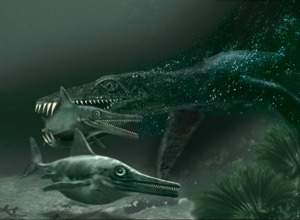The monster of the northBy Jørn H. Hurum and Hans Arne Nakrem, Museum of Natural History, the University of Oslo

Imagine an animal as long as a bus, whose teeth are as long as cucumbers. Imagine that these teeth are in a mouth so large that a grown man can be placed on the tongue and swallowed whole… The world would never be the same again after 5 August 2006. At least it wouldn’t be for the participants of an expedition called “The Lizard Hunters 2006”. They found a fossil skeleton of one of the largest carnivorous marine reptiles ever: a pliosaur. The skull was at least 2.1 m long, and the vertebrae stretched out 6 m along the mountainside. It had been perfectly preserved; only a few vertebrae and the snout had disappeared over the edge of the mountain. After the last expedition in 2004, the expectations of finding something were sky high. There were no disappointments, and the Isfjorden area is now amongst the four best places in the world for finding marine reptiles. Through the course of 11 strenuous days, 28 fossil skeletons were found and mapped – all belonging to marine reptiles, ranging in size from a couple of metres long to almost five times that length. These animals lived in the sea that covered Svalbard around 150 million years ago. As expected, the skeletons were already familiar to the scientists from their 2004 expedition – with one exception: the skeleton found by Bjørn Funke late in the evening on 5 August was something completely different. After spending only a few minutes at the discovery site, the scientists concluded, “there’s a monster here”. The coarse structure of the bones and the size of the vertebrae were signs of the ultimate dream – one of the largest animals ever to have lived on Earth. The animal’s snout had disappeared down the mountainside and was collected. The pieces were later glued together and identified. The teeth were triangular, which is a distinctive feature of the pliosaurs. These are among the largest carnivorous reptiles that have ever lived. They preyed on other marine reptiles, including ichthyosaurs and plesiosaurs. Fossilized skeletons have been found in England, Russia and Argentina. There are no whole fossil skeletons, so the discovery in Svalbard will play a major role in improving our understanding of these massive monsters. Liopleurodons were more famous relatives of pliosaurs, but they were so similar and we have so few fossils that the scientists cannot agree whether they were actually two different groups of prehistoric marine reptiles. Maybe this question can be answered by the amazingly well preserved fossil in Svalbard. Updated June 2008 |
The Cruise Handbook is also available in book formHard cover with numerous pictures - 249 pages - NOK 249.00 Norwegian Polar Institute |
 Norsk
Norsk